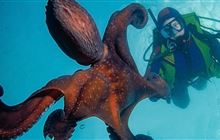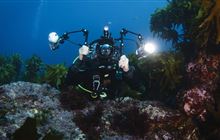From mountains to sea to space – measuring ocean health on the Kāpiti Coast
Archived content: This media release was accurate on the date of publication.
Introduction
This Friday, the Kāpiti Coast is getting a high-tech addition with the installation of a new buoy on the edge of the Kāpiti Marine Reserve.Date: 20 November 2020
The buoy is a ‘sister’ to the one in Wellington Harbour – a familiar figure to many residents, which sits just south of Matiu/Somes Island in hi-vis yellow. Both buoys provide real-time measurements on currents and waves, salinity, oxygen and chlorophyll, water temperature, sediment, wind direction and speed.
“Having these two buoys measuring the conditions at two very different locations is an amazing resource for learning more about the effects of surrounding land on ocean water quality,” says Laura Wakelin, Technical Advisor at DOC. “The cities surrounding Wellington Harbour are highly urban, which affects the water quality in the harbour. We’re interested in capturing these data on the Kāpiti Coast as it undergoes rapid urbanisation. It will also alert us to changes in water quality which may have a knock-on effect on marine species living within the boundaries of the Kāpiti Marine Reserve.”
With the Ōtaki and the Manawatu rivers converging on the Kāpiti Coast, the site chosen for this new buoy is great for exploring the interconnectedness between ecosystems, says Dr Joe O’Callaghan, physical oceanographer at NIWA, “This buoy will tell us about all kinds of things in the ocean, but particularly about rivers and how they connect to the land. We’re working with the local communities, so they’ll be able to understand what changes are happening on land, and what the response in the ocean is.”
All data will be made available to the public, becoming an important source of information for the local community, iwi, divers, students, fishers, and tourism operators.
However, the benefits extend far beyond local communities. While the buoy is busy taking measurements throughout the water column, there are satellites overhead monitoring the sea surface for changes.
“One of the most exciting uses of this technology is the ability to ‘sea-truth’ measurements from satellites,” says Greater Wellington Regional Council’s Dr Megan Melidonis, Senior Coastal Scientist. “By comparing the measurements from the buoy and satellite imagery, we will get a sense of how accurate the satellite data is for certain measurements. This could open the door for future remote monitoring, which is much less resource-intensive than physical monitoring.”
This project is a joint venture between NIWA, the Greater Wellington Regional Council, and DOC, and is partially supported through Air New Zealand’s support of the Marine Sentinel Sites Programme.
Background
This buoy will set a baseline for water quality in this area, helping to make better management decisions and respond quickly to any changes.
NIWA has provided the majority of funding for this project, with Greater Wellington Regional Council and DOC (via the Sentinel Sites Programme) providing smaller portions of the funding.
An example of data availability is given for the Wellington harbour buoy here: Greater Wellington Regional Council Environmental Monitoring and Research
Collaboration is a strong focus for the Marine Sentinel Sites Programme, a commercial partnership between DOC and Air New Zealand, which has contributed the DOC portion of funding for the buoy and sensors.
Contact
For media enquiries contact:
Email: media@doc.govt.nz


